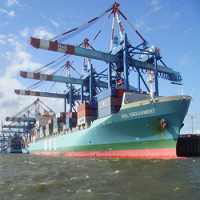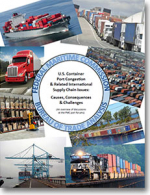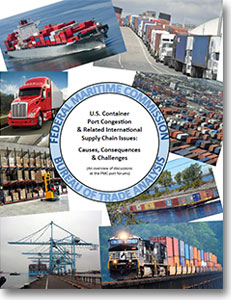U.S. Container Port Congestion & Related International Supply Chain Issues
Congestion is a serious challenge to America’s continuing economic growth and competitive position in the world economy.
The report organizes and further develops stakeholder discussion around six major themes that emerged at the 2014 FMC Port Forums held at major gateway ports – investment and planning; chassis availability and related issues; vessel and terminal operations; port drayage and truck turn-time; extended gate hours, PierPASS and congestion pricing; and collaboration and communication.
These forums provided a unique opportunity for industry stakeholders to gather around the country to share their views on the causes, consequences and challenges surrounding congestion at ports and other parts of the intermodal system, as well as share ideas for possible solutions.
The report addresses current and anticipated future challenges caused by congestion at U.S. port gateways, and comments on the causes and effects of congestion with the objective of facilitating further discussion on potential solutions.
Chairman Cordero stated: “International trade relies on our nation’s ports, therefore port congestion is a paramount question at the international supply chain level, and is not a solely domestic concern. In July 2014, President Obama moved the Build America Investment initiative forward. Inclusive in the initiative was the need for investment in our ports. In line with the Administration, the Commission is committed to addressing the question of congestion at our vital port gateways. Infrastructure investment is at the core of the discussion, however, other factors must be addressed in the near term to ensure an efficient and reliable international ocean transportation system and the relevant supply chain.”
Organization of the Report
The functioning of three interconnected commercial markets were unequivocally at the epicenter of the FMC forum discussions on port congestion and related international supply chain issues.
These markets were chassis provisioning, port drayage, and the servicing of vessels in terminals.
A summary of the forum discussions tied to these markets is presented in turn following a summary of discussions that took place regarding the need for investment and adequate planning.
It was widely acknowledged at the forums that if investment falls behind the needs of the U.S. intermodal industry, the episodic congestion of the last two decades is certain to be repeated, perhaps with more profound consequences than those now being experienced.
What’s Related


Favorites





